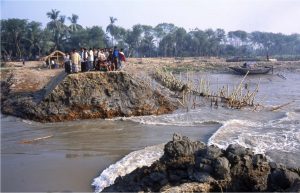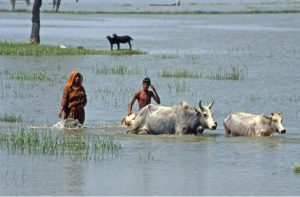Memo #265
By Mustafa Alam – mstfalam [at] gmail.com
 A case study from Bangladesh highlights the success of a negotiated approach to water resources management, wherein the participation of the local populace in the planning and decision-making process is ensured, local knowledge is used and local stakeholders empowered.
A case study from Bangladesh highlights the success of a negotiated approach to water resources management, wherein the participation of the local populace in the planning and decision-making process is ensured, local knowledge is used and local stakeholders empowered.
In the Khulna and Jessore districts of coastal Bangladesh, flood protection polders (land enclosed by an embankment to protect against the overflow of river water) were causing silt deposits at the regulator gates, resulting in severe water-logging and threatening the livelihood of local farmers. To mitigate this problem, the Bangladesh Water Development Board (BWDB) launched the Khulna-Jessore Drainage Rehabilitation Project (KJDRP) in 1995. Their proposed answer? Dredge the riverbeds and construct a large regulator downstream. But the local people argued that a large regulator would only enhance silt deposits, thus accentuating rather than alleviating the problem. Through various forms of protest they let it be known that following the riverbed dredging they preferred the construction of an upstream tidal basin for creating a tidal regime capable of scouring the riverbed to maintain a natural flow of water.
Recognizing the local concerns, the Asian Development Bank—the project’s financier—suggested an environmental and social impact assessment of alternative options, which was conducted by the Center for Environmental and Geographic Information Services (CEGIS). CEGIS heeded local concerns and suggestions, and proposed a testable ‘tidal river management’ (TRM) option, with periodic relocation of the basin. The impact assessment found the TRM option to be the preferable one, for both environmental and socio-economic reasons. Its completion in 2002 saw the gradual reduction in water-logging, with the result that agriculture received renewed impetus, local poverty levels declined and overall livelihood conditions improved.
Challenges remain, including ensuring compensation for those households that had land within the constructed tidal basin and building and maintaining the consensus essential for rotating the TRM basin among geographical locations. Also important is ensuring cooperation among local Water Management Associations and other local bodies for performance monitoring as well as the operation and maintenance of the system. Notwithstanding these challenges, this case study in Bangladesh may serve to illustrate the utility and fairness of the negotiated approach, not only to water management but to other issues critical to the lives and livelihoods of local stakeholders.
About the Author:
Muhammad Mustafa Alam is a Professor in the Department of Economics at the University of Dhaka, Bangladesh. He has a special research interest in water resource management and is spending 2013–2014 as a visiting faculty member in the Centre for India and South Asia Research, Institute for Asian Research at the University of British Columbia.
Links:
- Both ENDS: Connecting People for Change
Related Memos:
See our other memos on Bangladesh.


Comments are closed, but trackbacks and pingbacks are open.